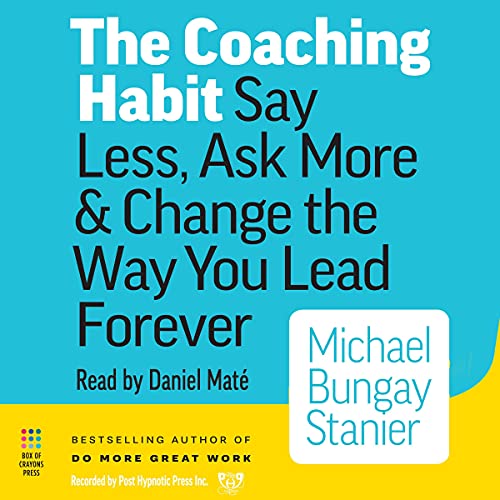
1 Line Summary
“The Coaching Habit: Say Less, Ask More & Change the Way You Lead Forever” is a book written by Michael Bungay Stanier, which provides a guide to becoming a more effective coach by asking powerful questions and creating meaningful conversations.
What Will You Learn
Here are some specific benefits of the book. You will learn:
- The power of asking questions,
- The importance of listening,
- The value of curiosity,
- The value of curiosity,
- The importance of trust,
- The power of creating a coaching culture.
Best Quotations from the Book
- “The best coaches ask great questions.”
- “The best questions create a sense of possibility.”
- “The best coaches are not problem-solvers. They are problem-seekers.”
- “The best coaches don’t have all the answers. They know where to find them.”
- “The best coaches are not afraid to be vulnerable. They are open to feedback.”
- “The best coaches are not afraid to be human. They are real.”
Book Summary
Here is an executive summary of the key takeaways from the book:
1. Powerful Questions
Powerful questions are those that help people to think more deeply about their challenges and to come up with their own solutions. They are open-ended, curious, and non-judgmental. They help people to see things from different perspectives and to generate new ideas.
The importance of asking powerful questions is that they help people to learn and grow. When we ask questions, we are giving people the opportunity to think for themselves and to develop their own problem-solving skills. We are also showing that our interest in helping them and that we value their input.
2. The 7 Essential Questions
The book “The Coaching Habit” identifies 7 essential questions that coaches can use to help their coachees:
- What’s on your mind? This question helps the coachee to share his thoughts and feelings about the challenge.
- And what else? This question encourages the coachee to think more deeply about the challenge and to explore all of the possibilities.
- What’s the real challenge here for you? This question helps the coachee to identify the root cause of challenge.
- What do you (really) want (from me)? This question helps the coachee to clarify what he is hoping to achieve from the coaching conversation.
- How can I help? This question allows the coach to offer his support and assistance to the coachee.
- If you’re saying yes to this, what are you saying no to? This question helps the coachee to consider the trade-offs involved in decision-making.
- What was most useful for you? This question helps the coachee to reflect on the coaching conversation and to identify what he learnt.
3. Cultivating the Coaching Habit
- Traditional leadership models often emphasize providing answers and solutions. However, “The Coaching Habit” advocates a shift towards a more empowering and sustainable leadership style.
- By instilling a coaching habit, leaders empower their teams to take ownership of their tasks and decisions.
- This approach not only enhances team autonomy but also establishes a culture of continuous learning and improvement, fostering long-term success.
4. The Power of Presence
- Being fully present during conversations not only enhances understanding but also communicates respect and empathy.
- Leaders who prioritize presence create an environment where open dialogue flourishes, enabling teams to address challenges effectively and build stronger, more authentic relationships.
5. Mastering the Art of Feedback
- Feedback is a cornerstone of growth and development. Effective feedback is a blend of insightful questioning and constructive insights.
- Leaders who embrace this approach provide their teams with actionable feedback that fuels improvement without demotivating.
- By combining powerful questions with constructive feedback, leaders create a balanced feedback loop that fosters continuous learning and drives performance excellence.
A Comprehensive Coaching Guide
This step-by-step coaching guide is inspired by the book and aims to provide leaders with a practical framework to implement the principles outlined in the book.
Step 1: Embrace a Coaching Mindset
- Recognize the value of coaching as a leadership style.
- Understand that coaching is about facilitating growth, learning, and self-discovery in others.
- Commit to becoming a coaching leader by adopting a curious and open approach to interactions.
Step 2: Master the Seven Essential Questions
- The Kickstart Question: “What’s on your mind?”
- The AWE Question: “And what else?”
- The Focus Question: “What’s the real challenge here for you?”
- The Foundation Question: “What do you want?”
- The Lazy Question: “How can I help?”
- The Strategic Question: “If you’re saying yes to this, what are you saying no to?”
- The Learning Question: “What was most useful for you?”
Step 3: Engage in Powerful Conversations
- Start conversations with open-ended questions to encourage deeper insights.
- Listen actively and without judgment to create a safe space for dialogue.
- Allow pauses to give the coachee time for reflection and exploration.
Step 4: Establish Clear Objectives
- Help coachees define their goals and desired outcomes.
- Ensure that coaching sessions have a clear focus and direction.
Step 5: Practice Active Listening
- Focus your attention fully on the coachee.
- Demonstrate empathy and understanding through your responses.
- Paraphrase and summarize to confirm your understanding and show that you’re engaged.
Step 6: Ask Follow-up Questions
- Use the “And what else?” question to encourage deeper exploration.
- Ask specific questions related to the coachee’s goals and challenges.
- Avoid jumping to conclusions or providing immediate solutions.
Step 7: Encourage Self-Reflection
- Guide coachees to reflect on their experiences, strengths, and areas for improvement.
- Ask questions that promote insight and self-awareness.
Step 8: Provide Constructive Feedback
- Use a combination of powerful questions and thoughtful insights to deliver feedback.
- Focus on strengths and opportunities for growth.
- Encourage coachees to explore potential actions and strategies.
Step 9: Foster Accountability
- Support coachees in setting actionable steps to achieve their goals.
- Encourage regular check-ins to track progress and celebrate successes.
Step 10: Cultivate Continuous Learning
- Emphasize the importance of ongoing self-development and learning.
- Encourage coachees to apply the coaching mindset in their interactions.
If you want to be a better leader, then you need to be a better coach. And the best way to be a better coach is to ask better questions. The Coaching Habit will teach you how to do just that.
For more insights, read “Creating Communications (Part-1)“, “Creating Communication (Part-2)”,“Exactly What to Say“, “How to Talk to Anyone“, “Just Listen“, “How to Win Friends and Influence People“, “Crucial Conversations” and “Relation between Self Awareness and Effective Communication“.


Pingback: "The Four Disciplines of Execution": Book Summary
Pingback: “The Manager’s Path” by Camille Fournier: Book Summary
Thought provoking points